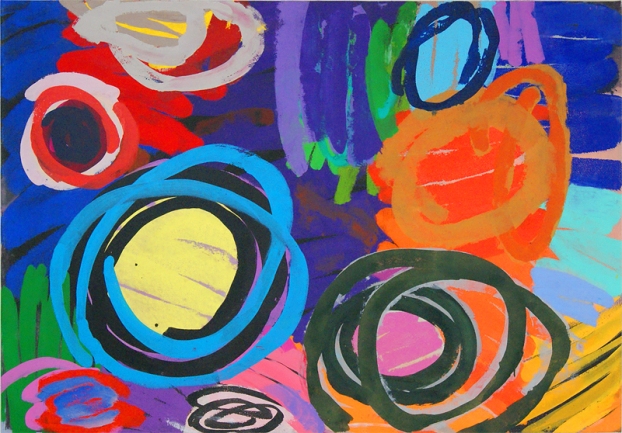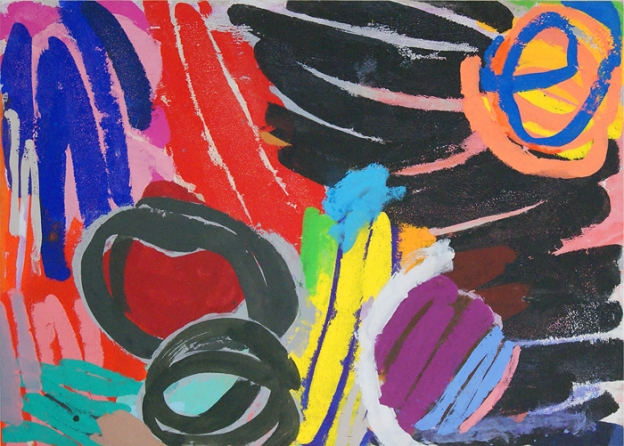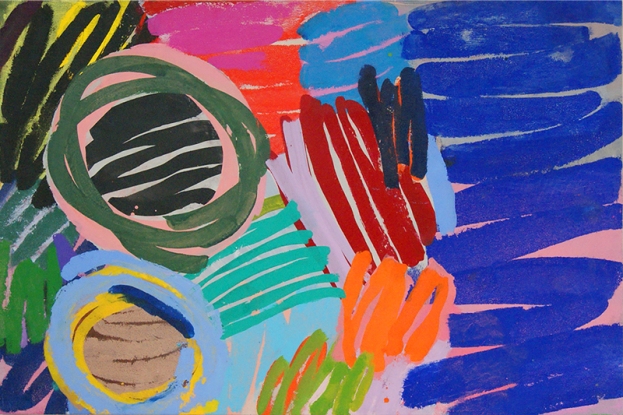Brancaster Chronicle No. 33: Emyr Williams Paintings
Dowlais, 2016, 122.5X176cm, acrylic on canvas
23rd April 2016, London.
Those present: Anne Smart, Anthony Smart, John Pollard, Nick Moore, Hilde Skilton, Mark Skilton, Robin Greenwood, Sarah Greenwood, Charley Greenwood, John Bunker, Emyr Williams, Noela James, Mark James.
Gwernllwyn, 2016, 120X170cm, acrylic on canvas
Morlais, 2016, 122X175.5cm, acrylic on canvas
Penydarren, 2016, 122X176cm, acrylic on canvas
Twynyrodyn, 2016, 123X174.5cm, acrylic on canvas





Another really good one!
And in this one Tony Smart identifies a garden hose!!! I was hoping Mark Skilton might see some snakes. Alas, Mark has yet to reach that level of enlightenment. (Mark does share some interesting uncertainties about color and drawing though.)
I see all of Indian civilization in Emyr’s painting. “All,” not in the sense of “all,” but in the sense of not just Indian painting. Of course I know next to nothing about Indian civilization. I have no idea whether or not Emyr has any interest in Indian civilization. I’m not trying to be amusing though. I’m simply thrilled by what seems to me (via the JPEGs: I haven’t seen the work “live”) a “deep”/“real”/maybe “complex” richness that’s IN the work, NOT brought by me to the work.
Early in the Chronicle John Bunker points to the upper right corner in Dowlais, an area that he describes as being “in the moment.” That seems to me to be important. “In the moment”—present—“presentness”—cosmic Oneness—whatever: it’s something maybe “bigger” than, at least different from formal unity. I kept thinking about cosmology as I listened to John. Of course I know next to nothing about cosmology.
I do know enough about Indian civilization to know there’s more to it than what you might find in Emyr’s paintings. There’s something necessarily “shallow”/“disconnected” about Emyr’s connection to India: Emyr, after all, is famously a Welshman, a compatriot of David Jones (or at least David Jones’s father). There’s something “postmodern” about my bringing in India: there’s something “postmodern” about my talking about Emyr’s work at all: it’s work I’ve never really seen: I’m not happy about that—but then I think of Tim Scott’s engagement with Indian “civilization”/sculpture: was it more direct/more explicit? How was it different? Was it different? Maybe bringing in Tim Scott is “contextualizing”—and “contextualizing” narrowly/unhealthily—but maybe “necessarily” for somebody watching from New York.
Am I trying to connect Emyr’s work to art-historical precedence—or simply to the world? Is connecting the work to the world “contextualizing” the work “unhealthily”? (I think the world is bigger than any “context.”) Is making any kind of connection somehow taking the focus away from the work? To what extent is the work focused just on itself?
Lots of questions, no answers. Same thing kind of happened in the Chronicle. Yves Bonnefoy, the GREAT French poet, says you can think about art in three ways: as an art historian, as an art critic, and as a poet. Thinking about art as a poet—as someone who understands something about how things are made—is the most fun. I think that’s the kind of “thinking” Robin sees happening at Brancaster. I think John spotted a “poetic” moment, a moment when the Music of the Spheres broke through and broke down the prose in Dowlais. But there’s always going to be lots of prose, lots of questions, when you start talking about art—lots of prose, lots of questions in the art itself—some fun too though.
LikeLike
These paintings definitely have a ‘wow’ element as well as ‘surge and undertow’ and the impact of them feels complete and resolved but there are areas of dissonance (possibly not entirely resolved?) which give them an edge and prevent them from being too comfortable.
LikeLike
Oh come on people! Alan Gouk says the proper response to a painting is “Wow!”, Noela repeats it, and……………. nothing.
Do I really have to get myself in deep doo doo with Goukmeister again? We’ve had decades of “Wow”. Mr. R. Mutt had a bit of “Wow” factor 99 years ago. I want more than that. I want something that sustains me in my relationship to a work, over time. Sometimes you are “wowed”, sometimes not. I can think of a number of great paintings that didn’t by any means “wow” me at first, but have gone on to provide a continuum of enjoyment. What of that? If there is one thing that abstract art doesn’t want to be competing with in popular culture, it’s “wow”, because lots of shit will out-“wow” it.
LikeLike
I do think that when paintings have a strong dazzling impact, won’t mention the ‘w’ word again, there can be a certain unraveling of that initial force. I feel there is a great deal of razzmatazz in these paintings, rather than a slow burn of interest, produced by more complex work, ( John Pollard and Anne Smart’s recent paintings come to mind). I feel that Emyr’s work hits you and stirs you every time you see it, and I feel this is where it’s strength lies rather than in slow contemplation.
LikeLike
Lets see if we can carry over some thoughts from John Bunkers feed,which he must be pleased with.I havent seen Emyrs pictures this time ,altho I saw the last group.He is Painting big splashy pictures.It seems fair to say he isnt reaching for the “feeling” mentioned in John Hoylands quotes from the Chelsea gig.In that sense ,altho gestural,they seem to relate more to Frank Stella working in series,as each picture doesnt need a key pulling point.Altho Im impressed by the overall activety,I feel let down by the slightly post-modernist aim of random choices,needing to carry the weight.Has the baby gone out with the bath water?I also wanted to have a go at Robins snide remark re.Hoffmann and planar spaciality not being Abstract ,but feeling figurative? Altho Hoffmann worked up sketches of Provincetown Bay, there is nothing inherently un-abstract in his lanquage .We develop a 3 Dimensional sense of space early on in life and it keeps us alive in crucial threatening circumstances.like driving at speed.Its no use looking at the patterns if you’re trying to decide whether that car is on your side of the road.Depth perception is fundamental,Hoffmann used it cunningly with stain and block ,wheres the problem with lanquage?Emyr paints big flat pictures ,which as Ive found, isnt easy at all,depending what you require from them.Bunker using collage may be side-stepping difficult Painting,Tony Smart may be right after all.Can you get my drift as Im fed up with people seeing windows and doors in my work.I dont see anything but form and structure,but Paint using the same pair of eyes I experience nature with.The only difference between me and Cezanne is acrylic and Cultural context.To answer Nick Serotas question to the Chancellor as to whether Contemporary Art should take over aspects of social services,the answer is a resounding NO
LikeLike
Emyr’s paintings are bold. Initially this is what I experience. Then on attempting to understand what the paintings are doing,my attention is drawn to some areas of colour, marks and shapes that are exciting and unusual, but do not necessarily connect with the entire painting. When a work is whole, you do not question it, it has arrived at clarity and says it all, taking it to another level. How would I take them further? No, this is not for me to think about as they are uniquely Emyr’s work and expression. When he does achieve a unified clarity, his paintings would be very special.
LikeLike
Sorry, but that last comment was made by Hilde not me.
LikeLike
No disrespect to Emyr,Im just trying to get some good arguments going .I feel Abstract Painting needs extreme discipline of Lanquage and Intention,formal completeness,feeling ,colour,the whole shebang.There is so much random rubbish out there,with no reason to exist.Ive been quilty often of trying new things and fallen on my arse in public,its the nature of the beast ,but how else to grow?Sculptors like Robin and Tony are less attached to Painting ,which has such a great history,even in Cubism,I for one ,dont wish to dump Modernism.Look at Juan Gris,Braque,even Henri Laurens .Look at Basil Beatties show at MIMA.Big Abstract Painting like Emyrs is the real deal.Its major ,mainstream and relevent,so no wonder its so hard! Sam ought to try it ,if hes going to write about it! Gender has no barrier,its all to do with the power of ones Imagination ,put into the material.Its a long way from the XFactor and Big Brother as its conceived in private and nobody applauds.Yet what people are Painting is the litmus test of our Culture.It sucks!
LikeLike
Broadly speaking, I agree with Hilde about Emyr’s painting. They seem to be somewhat in the nature of studies – “if we do this and this, then that happens”. I also think that as they become spatial, they become figurative. But what is worth mentioning, because it doesn’t come across at all in reproduction, is the very thoughtful and accomplished paint quality – “open”, matt, broken but opaque – one of the best uses of acrylic I’ve seen.
LikeLike